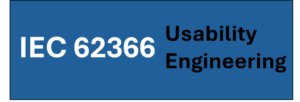62366

ISO/IEC 62366 is an international standard that focuses on the usability engineering process for medical devices. It ensures that medical devices are designed with user needs and capabilities in mind, thereby minimizing use errors that could result in harm to patients or users.
The standard guides manufacturers in applying usability engineering to ensure safe and effective interaction between users and devices, thus meeting the regulatory requirements for market access, including CE marking and FDA approval.
Importance of Compliance
Usability failures are a leading cause of adverse events in healthcare settings. ISO 62366 helps to address these issues by promoting a user-centered design approach.
Non-compliance with ISO 62366 may lead to product recalls, patient harm, or difficulty in obtaining regulatory approvals. Complying with ISO 62366 contributes to safer products, enhanced user satisfaction, and smoother regulatory processes.
Key Features of ISO 62366
– Usability Engineering Process: The standard provides a structured process for incorporating usability engineering throughout the development lifecycle of medical devices.
– User Interface Evaluation: It requires manufacturers to evaluate the user interface of their devices to identify potential use-related hazards and reduce risks.
– Human Factors Validation: Manufacturers must perform usability validation testing to verify that the device can be used safely and effectively under real-world conditions.
– Iterative Design: The standard emphasizes iterative design processes, including prototyping and user testing, to ensure that usability concerns are addressed early in development.
Scope of Application
ISO 62366 is applicable to all types of medical devices, from complex diagnostic systems to simple tools like syringes, as well as software as a medical device (SaMD).
ISO 62366 covers both hardware and software user interfaces, ensuring that all aspects of device interaction are evaluated for safety and efficiency.
Steps for Compliance
- Define the Intended Use: Clearly identify the intended users, uses, and use environments for the medical device.
- Identify Use Scenarios and Hazards: Analyze use scenarios and identify use-related hazards that could affect patient or user safety.
- Establish Usability Requirements: Develop usability requirements that mitigate the identified risks and ensure user-friendly interaction.
- Usability Testing and Evaluation: Perform formative usability testing to refine the design and summative testing for usability validation.
- Documentation: Maintain a usability engineering file documenting all activities, findings, and risk mitigations throughout the process.
- Audits and inspections: Prepare your business on audits and inspections. Identify and correct potential discrepancies before the authorities visit.
Resources and Guidance
ISO 62366 Document: Access the official ISO 62366 standard here.
Latest Updates and News
Revised Guidelines Available: The latest ISO/TR 62366-2 technical report provides additional guidance on usability engineering for medical devices.
Contact Information
For help with 62366 compliance, email us at info@scengineering.dk or use the contact form.